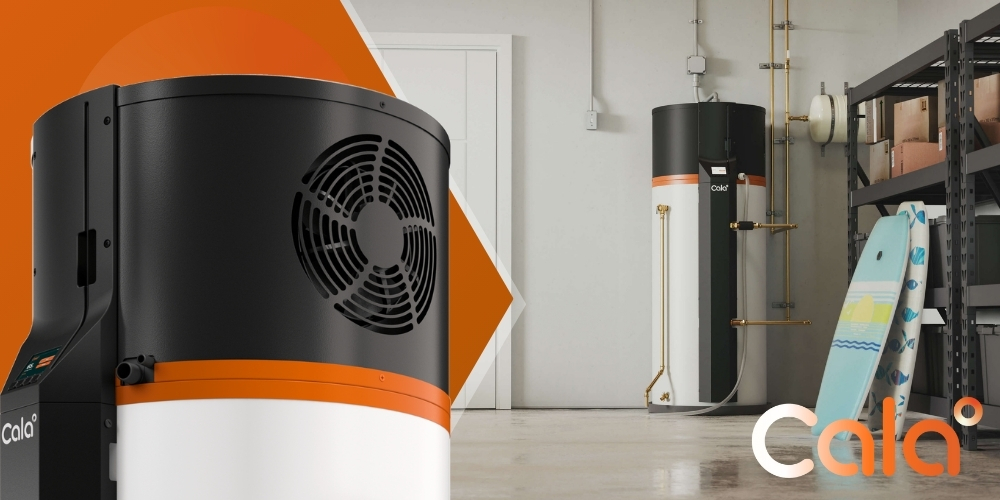Choosing the Right Bathroom Vent Fan and Heater Combo

Intelligent Heat Pump Water Heaters for Massachusetts Residential Homes — Why SumZero Selects Cala
By SumZero Energy Systems — Massachusetts’ #1 Heat Pump Installation Team
Picking a new water heater once involved a simple decision between gas and standard old electric, praying the hot water wouldn't be gone when there were two showers in a row. That's no longer the case. Now, the ideal solution for the majority of Massachusetts homes is a smart heat pump water heater (HPWH). This isn't the typical hybrid of which you might have heard, but a rather new breed of unit that adapts to your home's schedule, accommodates your energy usage, and maintains comfort consistently while consuming a lot less energy.
When homeowners want to have it exactly right the first time, our team is discerning about what products we choose. We consider the landscape and inspect the details before determining that they might work with Cala, a company that produces a high-technology hot water heater that modern homes need: intelligent, consistent, and efficient hot water — installed properly. This article describes why this alliance matters, how the tech benefits your home, what you should expect from our installation, and the handy information (rebates, credits, fit questions) homeowners inquire about daily.
Why This Alliance Is Important
(and What It Does for You)
There are two parts to a successful hot water solution:
Great technology
A system that makes you comfortable and uses less energy.
Great installation
Design, placement, airflow, electrical, condensate handling, commissioning, and long-term support.
Cala provides a tailor-built, smart HPWH platform. SumZero provides actual-world experience so that it works perfectly in real Massachusetts homes.
Together, we provide three things homeowners report wanting:
Accurate hot water at peak periods without guessing.
Cheaper monthly energy bills without compromise on comfort.
It is a future-proof solution that addresses the trend towards greener, all-electric homes.
Simply put: We get hot water. We know how to properly install heat pump technology. This combination makes a water heater upgrade a smart, long-term decision.
The Homeowner's Dilemma That We Are
If you have had a gas or a typical electric water heater, then you know the problems:
Hot-cold swings on hectic morning routines.
Higher electricity bills than hoped for.
No real insight, no real control.
A replace cycle that is experienced as "buying the same thing again."
Typical hybrid: Heat pump water heaters perform better, yet they still react: They delay until the tank cools off, then warm it up again. Homeowners averred they desire a system which thinks ahead—a unit which is a breeze to operate, handles peak load graciously, and does not make them compromise.
They fill that gap, which is why we work with them.

Why a Smart HPWH is Different
A standard electric water heater makes heat by passing an electric element, a giant toaster coil, through the tank. A heat pump water heater does it another way: it takes heat from the air it lives in and puts it into the water. Because it costs less energy to move heat than create it, heat pump water heaters run on much less power than typical electric ones. And they avoid burning gas, venting, and pollution.
A smart HPWH goes one step further:
It adapts to your home's schedule (morning showers, nighttime laundry) and preheats when demand isn't yet high.
You can use the app to check, plan, or increase hot water whenever you want.
It has a compressor that can change speed to fit what you need (not just "on/off").
It is achievable with a mixing valve holding water at the proper warmth for improved efficiency and then providing a sustained, safe warmth for usage. This is also possible with the availability of additional warm water at peak usage times.
It goes nicely with a contemporary home — primed for solar, time-of-use, and information you can view at a glance.
Result: more stable comfort, less energy use, improved control.
Why a Smart HPWH is Different
From what is visible on-site, there are three things certain for homeowners regarding the points of Cala:
1) Ease That Is Effortless
Consistent hot water at peak use is the ultimate test. Through forecasting demand and using a mixing valve, Cala maintains a steady supply. That results in less "uh oh" when two showers coincidentally happen at once or someone turns on the dishwasher.
2) Controls That You'll Ever Use
App functionality is key when done properly. You can check if there's hot water, turn up the heat for guests, view energy usage history, or simply set it and leave. As installers, we appreciate performance data — it allows us to address little issues before large ones form.
3) Future-Ready from Day One
Massachusetts is going towards clean, electricity-based homes. Cala's strategy combines well: it is scalable for solar power and accounts for time-of-use rates when needed. If you foresee solar energy at some time, or already have it, this water heater won't stop your home from being efficient.
4) A Company That Stands Behind Its Product
Cala backs every unit with a 10-year parts warranty and 3-year labor warranty — a strong sign they stand behind both the technology and the people who install it. At SumZero, we respect that kind of commitment because it mirrors our own approach: taking care of homeowners and supporting our partners with the same level of trust and accountability.
What SumZero Offers As Your Installer
(Why It Matters)
Even the best system won't work so great if installed wrong. Our task is getting your new HPWH working perfectly inside your home, not on a drawing board. This is what our approach is:
Right-size design.
We measure how much water your home needs and discuss the high-flow fixtures, filling bathtubs, and washer usage.
Best installation and ventilation.
HPWHs require air to make the heat move. We consider the room size, doors, vents, and — when necessary — ducting solutions for high performance and low noise.
Clean handling of electricity and condensate.
Safe power, tidy routing, and a trustworthy drainage plan are essential.
Commissioning correctly.
We don't just "turn it on." We verify performance, position the mixing valve, help you with the app, and verify your comfort objectives.
Rebates, credits, and financial assistance.
Mass Save, federal 25C, and the 0% HEAT Loan (if applicable) — we'll help you with that.
We take special care.
Our teams respect your home, protect your floors, and leave the place nicer than they found it.
Aftercare you can count on. Questions years down the road? We're here. The whole concept of a smart system is long-term confidence, not a one-day installation.
Costs, Incentives, and Lifetime Value
Two parts matter here: upfront cost and operating cost.
→ It is a better unit than a standard electric or simple hybrid. Tax credits and rebates make a big difference. A lot of Massachusetts homeowners rely on the 0% HEAT Loan for easier payments.
→ Month after month, the intelligent HPWH's effectiveness is where the value lies. By transferring (not creating) heat and by scheduling heating intelligently, homeowners consistently experience significant decreases in water-heating energy consumption — particularly relative to resistance electric, and many times relative to gas or delivered fuels when full costs are factors.
If you'd like figures specific to your home (household number, showering usage, energy costs), we'll do the math at your consult and provide you with a clear estimate of payback, lifetime cost saving, and the rebates for which you qualify.
Are Smarter Heat Pump Water Heaters Good for Your Home?
It is feasible for many Massachusetts homes. We will cover:
→ Household size and routines. Families with up to about 5 people usually do well with the standard setup; we will give advice for larger families or special situations.
→ Space and ventilation. We check the space, door vents, or ducts if necessary, and ventilation so the system operates properly.
→ Location. Basements are typical, as are utility rooms. As the unit functions, it removes air that feels like a dehumidifier — a typical plus for basements.
→ Electrical. We check panel capacity and proper wiring; no installation day surprises.
→ Future plans. Now or in the future for solar? Time-of-use rates? We'll put the system on so it grows with your home.
[[cta-heatpump]]
Why Is Cala Different from "Traditional Hybrids"?
✪ Control and Convenience:
Cala integrates intelligent tech with a mixing valve to remain comfortable, even when it is busy. Most standard hybrid units have simple modes and react only when the tank becomes chilled.
✪ Care and Trust:
Performance insights help you recognize problems early on and keep you on your feet for surprises. Traditional deployments are mostly "wait and see."
✪ Timing and Efficiency:
Variable driving and improved scheduling assist in energy saving with the maintenance of comfort. Ordinary hybrids operate more often and at undesirable times.
✪ Future-Ready
The design of the Cala accommodates with solar power, intelligent homes, and plans for utilizing electricity. Most older hybrids were not built for that usage.

What to Expect with SumZero
(From the First Call Through the First Shower)
✪ Talk & Pictures
We'll first glance at your objectives and take some fast photos of the current installation: the water heating unit, panel, and surrounding room.
✪ Right-Fit Design
We fit your hot water consumption and available spaces to a design which we endorse.
✪ Chaplain: A Comprehensive
Your quote is going to be transparent, includes information for installation, accessories, and a checklist for incentives. The paperwork assistance takes care of our end.
✪ Professional Installation
Licensed, insured, and detail-orientated. We dispose of the old unit, prepare the site, install and commission a new system, and leave the site tidy.
✪ App Introduction and Instructions
You'll discover how to see hot water supply, schedule increases, and view consumption — without being "technical."
✪ Support and Help
We're your long-term partner. Got a question? You call us — that's what homeowners deserve from the #1 heat pump installation company.
Common Questions We Get
(And Easy Answers)
Smart heat pump water heaters move heat from the surrounding air into the water instead of generating heat directly. This makes them up to three to four times more efficient than standard electric models. Cala’s intelligent system takes it further — it learns your household’s patterns, preheats before busy periods, and gives you app-based control to monitor or boost hot water anytime.
Most hybrid water heaters react when the tank cools. Cala predicts when your home will need hot water and heats proactively, saving more energy while maintaining comfort. It also features a variable-speed compressor, integrated mixing valve, and performance monitoring portal, giving both homeowners and installers a smarter, more reliable experience.
Savings depend on your energy source and usage, but many Massachusetts homeowners cut their water-heating costs by 50–70% when switching to a heat pump system. Cala’s intelligent controls add even greater efficiency. Add Mass Save® rebates, federal 25C tax credits, and potential 0% HEAT Loan financing, and most families see real payback within just a few years.
Yes — most Massachusetts homes are a great fit. Cala’s 65-gallon design comfortably serves households up to five people and can prepare up to 90 gallons ahead of peak use. The system needs adequate space and airflow, similar to a dehumidifier, and our team at SumZero handles every detail — from placement and ducting to electrical and performance checks.
SumZero Energy Systems is Massachusetts’ #1 heat pump installation team, trusted for precision, transparency, and high-quality service. We manage every step — design, installation, rebate paperwork, app setup, and long-term maintenance — so homeowners enjoy smarter comfort and lasting confidence. With SumZero, you’re not just buying equipment; you’re gaining a partner who stands behind it.
Why We Feel Secure Recommending This to Massachusetts Homeowners
We have a simple promise: we only install solutions that we would use in our own homes. Cala’s approach — being smart, having control, and being ready for the future — matches what we have learned from many talks with homeowners in the state. Together with SumZero’s careful installation standards and ongoing support, this water-heating upgrade makes sense right away and will last well with your home. Cleaner heat. Smarter comfort. Fewer bills.
Ready to Take the Next Step?

To learn more about Cala’s technology and vision, visit Cala Systems.
Why a Bathroom Vent Fan and Heater Combo is a Smart Upgrade in Massachusetts
Upgrading to a bathroom vent fan and heater combo isn’t just a matter of comfort—it's a decision that improves air quality, prevents moisture damage, and adds instant warmth during chilly Massachusetts winters. This all-in-one solution is especially appealing for older homes where ventilation often falls short of today's comfort standards.
How Moisture Impacts Massachusetts Bathrooms
Massachusetts homes often experience high indoor humidity, especially in bathrooms with poor ventilation. Over time, unchecked moisture leads to:
- Mold and mildew growth on walls and ceilings
- Peeling paint and warped wood trim
- Reduced lifespan of cabinetry and finishes
- Foggy mirrors and uncomfortable condensation after showers
A vent fan with built-in heat clears humidity while warming the space—no more stepping out of the shower into cold air. An effective bathroom vent fan heater light makes your bathroom healthier and more inviting.
Moisture is the #1 cause of bathroom deterioration in Massachusetts homes, often leading to costly repairs that were entirely preventable.
Advantages Beyond Comfort
Pairing ventilation with a heating element in one unit isn’t just efficient—it’s budget-friendly and safety-oriented:
- Heats only when needed, reducing energy waste
- Prevents frost buildup on windows and mirrors
- Promotes faster drying of towels and surfaces
- Minimizes risk of slips caused by wet floors
You’ll get everyday comfort that pays for itself over time in reduced energy use and fewer repairs.
[[cta-heatpump]]
Choosing the Right Bathroom Vent Fan Heater: What Massachusetts Homeowners Should Know
Not every unit fits every space or meets the unique needs of New England homes. It’s important to know what to look for before making a purchase.
Consider Room Size and Insulation
Your bathroom’s square footage is the first decision point.
- Small bathrooms (under 50 sq. ft): Choose a unit with an airflow around 50 CFM
- Medium rooms (50–100 sq ft): Opt for 70–90 CFM models
- Large bathrooms: Go with 100+ CFM units to ensure proper ventilation and warmth
Massachusetts homes with older insulation may benefit from a stronger heater to offset heat loss.
In homes built before 1980 in Massachusetts, bathroom walls often lack modern insulation—smart heating and ventilation choices help bridge that gap.
Prioritize Quiet Performance
Check noise ratings, known as “sones.” The lower the sone rating, the quieter the fan.
- 0.5–1.0 sone: Extremely quiet—ideal for master bathrooms
- 1.5–2.0 sone: Moderate noise, suitable for guest or secondary baths
- 2.5+ sone: Considered loud—budget models often fall here
A quiet bathroom heater vent light fan allows for relaxing baths without the loud hum of older models.
Choose Integrated Lighting Features
Many fans include practical extras like:
- LED light fixtures to brighten your vanity area
- Night-lights for safe navigation during nighttime
- Multi-switch wiring to control fan, light, and heat separately
These added functions reduce clutter by eliminating the need for separate heating lamps or light fixtures.
Matching Your Bathroom Fan Choice With Other Venting Systems
Many Massachusetts homeowners are upgrading not just their bathrooms, but also how they vent heat and hot water throughout the home. A well-planned ventilation strategy considers the roles of bath fans, heaters, and water heater systems together.
Understanding Power Vent and Direct Vent Systems
If you’re updating your bath fan, you may also be considering water or space heating. Both power vent water heater and direct vent wall heater options function with building airflow in mind.
A power vent system uses a fan to push exhaust through horizontal pipes, allowing for flexible positioning. A direct vent water heater pulls air from outside and sends exhaust out the same way—ideal for tight indoor spaces.
These systems:
- Work efficiently with modern vent pipe designs
- Stay sealed from indoor air, improving indoor air quality
- Are often eligible for Mass Save® energy rebates
Linking these types of heating systems with your bathroom upgrades offers whole-home energy savings.
Efficient Vent Pipe Planning
To ensure your bathroom vent fan and heater operates effectively, its exhaust must not conflict with other nearby venting systems, such as:
- Water heater vent pipes
- Clothes dryer exhausts
- Kitchen range hoods
Plan vent routes to avoid backdrafting, where one exhaust pulls air from another system. This type of oversight is common in New England homes that were retrofitted rather than built with unified systems.
Improper venting is one of the leading causes of indoor air quality complaints and backdrafting risks in Massachusetts homes.
Top Features Massachusetts Residents Should Look For in a Bathroom Fan with Heater
With many models on the market, how do you choose the best bathroom fan heater for your space? Prioritize long-term value and practicality over flashy extras.
Look for Energy-Efficient Options
Energy-saving models often include:
- LED lighting with low energy draw
- Motion-activated sensors
- Timers to cycle the fan off after a set duration
These small features cut down on daily energy waste and may qualify for Mass Save® incentives.
Focus on Durable Materials Suitable for Cold Climates
Massachusetts winters take a toll on HVAC components. Look for bath fans with:
- Stainless steel or rust-resistant housing
- Motor protection rated for high humidity
- Fan blades that resist warping from moisture
These qualities extend the life of your unit and improve year-round performance.
Choose Proper Mounting for Your Home Structure
Bathroom fans are commonly ceiling-mounted, but if your ceiling has insulation challenges or limited space, wall-mounted options are available.
Wall-mounted bath vent with heater units:
- Are easier to install in retrofits or remodels
- Avoid interfering with low attic clearances
- Provide directional airflow to smaller bathrooms
This is especially useful in Massachusetts’ older cape-style homes and split-level constructions where ceiling access is limited.
Final Thoughts: Long-Term Value of Smart Bathroom Ventilation
Investing in a quality bathroom vent fan heater light provides everyday convenience, seasonal comfort, and long-term protection. Whether you're fighting mold, heating a chilly space, or modernizing your home with energy-efficient systems, choosing the right combination fan makes a difference.
When paired with efficient water heater power vent systems and appropriate vent pipe layouts, your bathroom becomes part of a larger comfort strategy across your entire home.
Explore options that match your home’s layout and prioritize air health, especially during Massachusetts’ long winters. You’ll not only feel the difference—but see it, in fewer repairs and lower energy costs.
For energy-saving tips and rebates for Massachusetts residents, visit Mass Save®.
Keep your bathroom cozy and mold-free with an efficient HVAC venting system designed for Massachusetts homes. Discover how a bathroom vent fan and heater combo improves comfort and air quality today!
Upgrade Ventilation NowYou Might Also Like…
Continue learning with handpicked articles that inform and inspire.
Not Sure Where to Start? We’ll Guide You
Let our experts design the right heating and cooling solution—customized for your comfort, your layout, and your energy goals. No pressure. Just clarity.
Request FREE ESTIMATE









